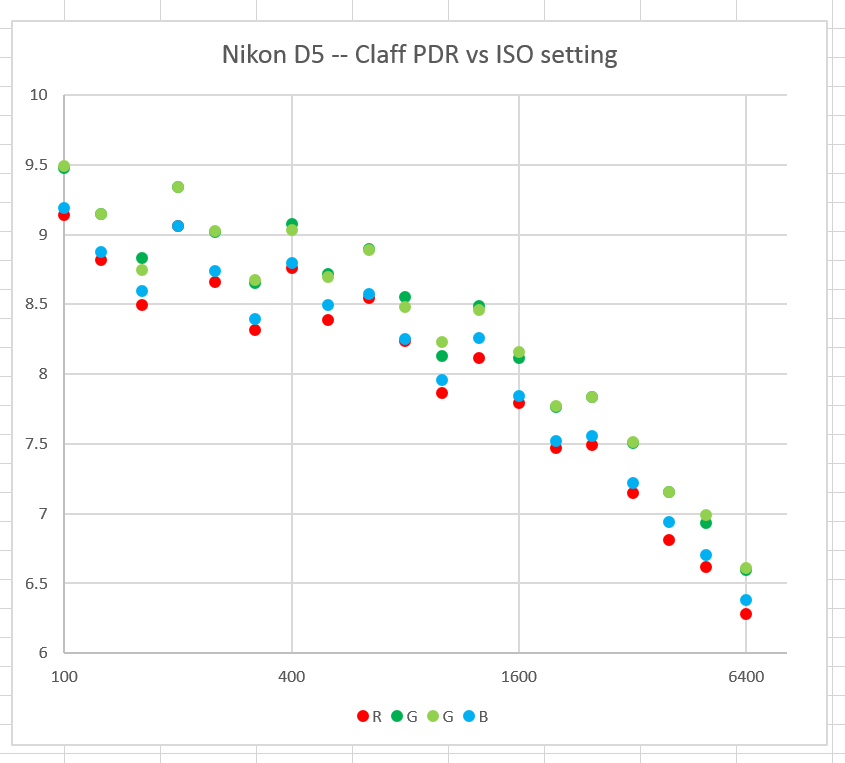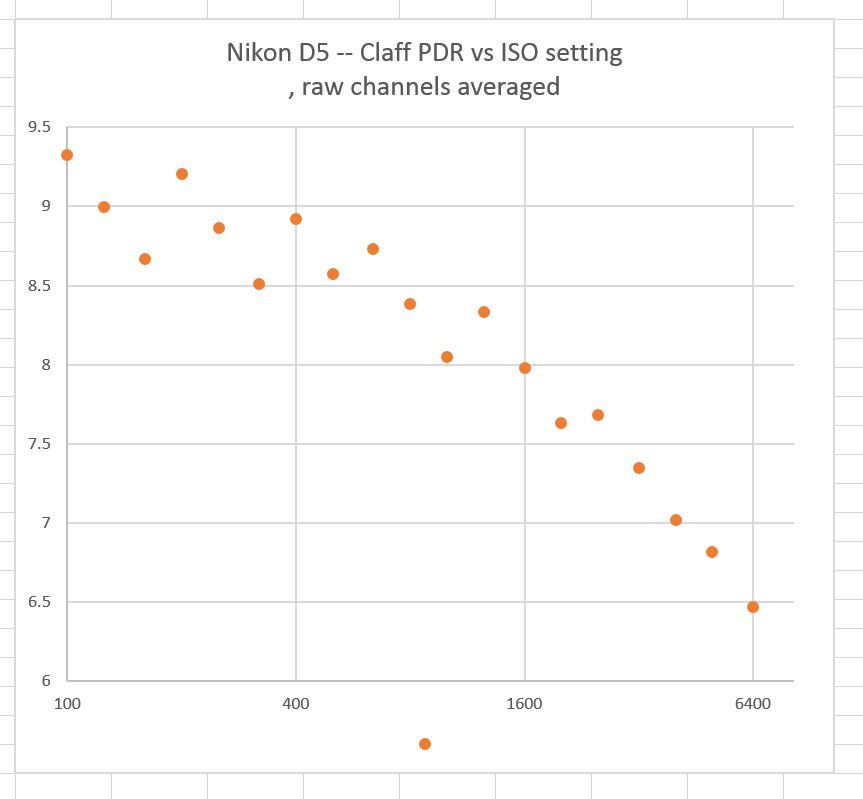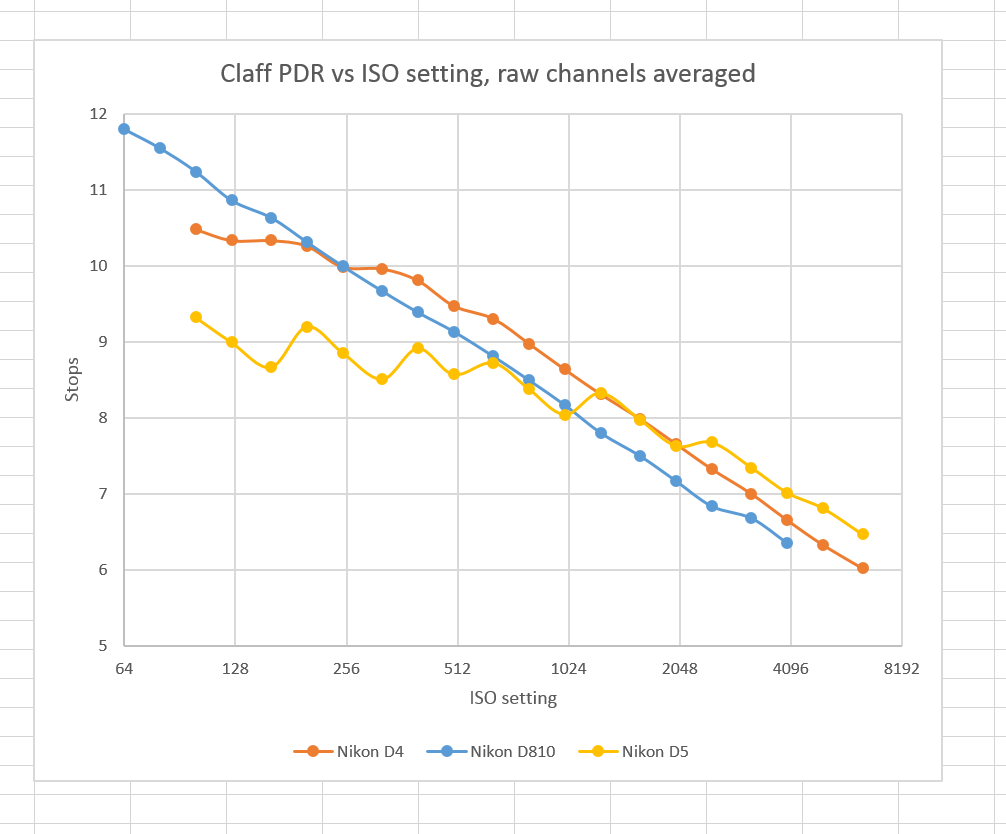This is part of a series of posts about the Nikon D5. The series starts here.
Let’s give the bookcase a little rest. I’ll get back to it with some high-ISO pictures, but first I want to talk about the D5’s photographic dynamic range (PDR).
We’ve already looked at the D5’s engineering dynamic range (EDR), and found that it was unusually low for a modern (non-Canon) camera at low ISO settings, and unusually high at when the ISO knob is cranked up. EDR is defined as one over the read noise, and is very easy to measure on cameras that don’t do in-camera black point subtraction; the D5 is such a camera. However, it’s not the greatest measurement for predicting the dynamic range of real photographs. Without modification, EDR is also resolution dependent in a way that favors lower resolution cameras.
PDR is defined as one over the signal (light) level that produces an acceptable amount of shadow noise. If the shadow noise threshold is defined appropriately, PDR can provide a level playing field across cameras of differing resolution. I use a definition for the acceptable-noise threshold invented by Bill Claff. He difines it as a signal-to-noise ratio (SNR). The magic number, which I call the Claff SNR, is 16000 over the image height in pixels for a 3:2 sensor like the one in the D5. I have extended this to sensors with other aspect ratios by normalizing to the sensor diagonal instead of the sensor height, but such nonstandard niceties aren’t necessary with the D5.
For the D5, the Claff SNR is 4.21. The Claff PDR is one over the signal (measured with respect to full scale) necessary to get that SNR. Doing a direct search for samples captured earlier for camera modeling produces this graph:
I’ve plotted the data for each of the raw channels, and you can see that there is some noise. Averaging all the raw channel data produces this graph:
How does that compare to the D810 and the D4? I’m glad you asked:
The D5 is worse than the other two cameras at ISO 100. It gives up a stop to the D4 and almost two stops to the D810. However, the D5 overtakes the D810 at ISO 640 and passes it at ISO 1000. The D5 catches up with the D4 at ISO 1250, and pulls away at ISO 3200,
One thing that I do to determine how ISOful or ISOless a camera is is compare the Claff PDR to what it would be if the camera were completely ISOless. Here’s what that looks like with the D5, the D4, the D810 and the Sony a7S:
You can see that the D810 is pretty ISOless. The D4 and a7S are pretty close, although the D4 flattens out after ISO 640. The D5 is by far the most ISOful. It’s interesting to note that the D4 and the D5 average slope are similar up to about ISO 500, but the D5 keeps on going from there and the D4 flattens out.




This is an excellent technical analysis of the D5. My experience with my D5 leads me to the conclusion that the dynamic rage is deplorable. For the most expensive DSLR that Nikon offers, this is not acceptable. I use the D5 in situations that require an ISO range of 22800 to 57600. I don’t expect a clean image, what I expect is consistency. Anything in a shadow is rendered as a black blob of well defined pixels. I have many examples of faces with no eyes. Even at lower ISO values, the D5 is disappointing. I hope Nikon corrects this with the D6.
Exposure is also not what I expect from the D5. I shoot in manual with auto ISO. Given the same scene with no change in light values, my D5 will properly expose for several shots, then underexpose by several stops for the next several. I photograph fast sports, and this is unacceptable.
My D5 had significant auto-focus problems. Nikon replaced the auto-focus system at no charge. In the meantime, it produced out of focus images.
I hope the D6 will be an improvement. Is Nikon aware of the issues with the D5?
Dunno. I certainly am not. My D5 has performed very well. There are lots of things I don’t use it for, though. It is not, nor was it designed as, a all-around camera.